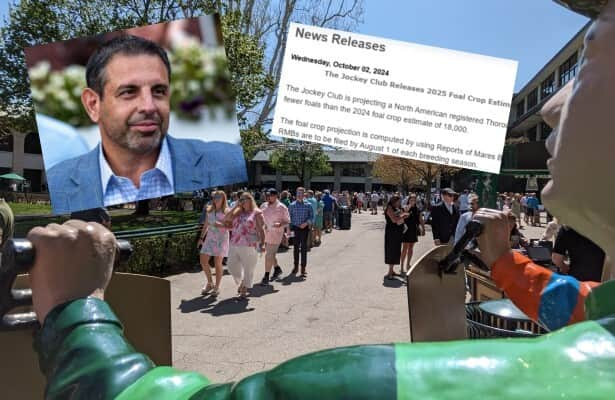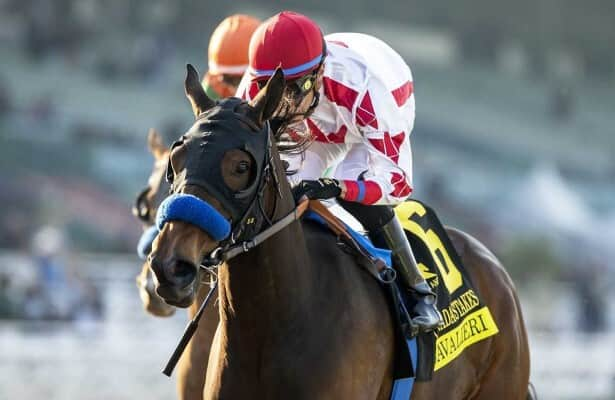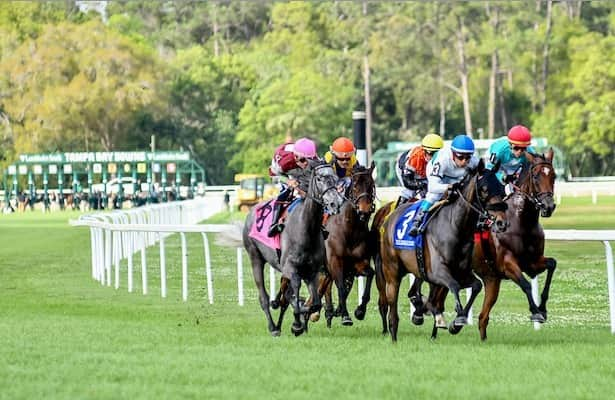Flatter: Wonders of foal crops, Thoroughbreds & Mike Repole

Lexington, Ky.
I wax lyrically and fondly about the drive between my home
in Louisville and the dreamland that is Keeneland. When I think of frequent
commutes I have had in my life, only the Merritt Parkway in Connecticut comes
close to matching the horse country of highway 60.
It is no secret that at the zenith of my being, I traveled a
lot. Not like those YouTubers Kara and Nate, who are on their second hundred
countries. But I have set foot in about two dozen nations and even lived on
another continent for three years. For a while I carried the expanded passport.
Three particular natural wonders are in my collection of
visits and memories. One of them, the Old Man of the Mountain in New Hampshire,
is gone. It came crumbling down from Cannon Mountain 21 years ago, exposing the
chains and steel rods that were used for decades in a desperate attempt to hold
it in place.
The second is the Twelve Apostles. Was. Those are rock
formations just off the coast of Australia in the Southern Ocean. Actually, there
were nine limestone pillars that were dubbed with the biblical monicker to
attract tourists. There are eight left after one of them collapsed in 2005,
just days after a friend and I visited them. I blame him.
The third is the Thoroughbred racehorse. They have been there
for me on six continents. Damned if I never get to the McMurdo Cup in Antarctica.
I have seen the finest equine breed in all its glory far and wide, female and
male, young and old, fast and slow, emphasis on fast when I adore them, slow
when I bet them.
This wandering travelogue is brought to you by Keeneland,
where another opening day arrives on what promises to be a perfect Friday. And
by the Commonwealth of Kentucky, pioneers of historic horse racing, those
machines that take a little and give back a lot. And by Mike Repole, the horse
owner and self-proclaimed racing commissioner whose 3,900-character post on X was
worth the pause in my press-box toils Thursday afternoon.
And so I have found a new way to play what recently has
become my one-string banjo. Yes, like an earworm, the latest report on
the foal crop is stuck in my head even as it erodes as steadily as the late
mountain man and the remaining apostles. Is it the foal crop or my head that is
eroding? It really does not matter at this point.
Well, in one case, it actually does. Pardon me for obsessing
about the equine population implosion. Someone has to. And thank goodness I am
not alone, even if it feels like there are few meaningful voices who can be
heard from the floor of this deepening abyss.
The Jockey Club told us this week the number of Thoroughbreds
born in North America last year would total 18,000, the lowest it has been in
60 years. That is down 65 percent from its peak of 51,296 in 1986. It used be
that we produced two racehorses for every one person who lives in Saratoga
Springs, N.Y. Now there are half again as many people there as new foals across
this great land of ours.
The state-by-state breakout had not yet been posted, but if
recent trends hold, this archipelago of Keeneland and Churchill and Turfway and
Ellis and Kentucky Downs will continue to create a bigger share of the racehorses.
The horse population in the commonwealth has dropped to fewer than 8,000 new
foals per year, but where it once bred only 1 of 5 horses in the country, now
it is about 2 of 5.
“Legislators have done an awesome job to help make the sport
more prosperous for Kentucky,” Repole said, no doubt seeing the generous purses
brought on by the incentives of governmental fiats. “But I don’t think they
thought about the effect that would have on the sport nationally. The success
of Kentucky is hurting outside tracks, outside breeders, outside owners across
the board. When these states, breeders, owners, trainers and horseplayers
eventually give up on racing, Kentucky racing and breeding will flounder.”
As much as this smacks of pouring rain on a parade of
success, he is right. At this rate Horse Racing Nation will become Horse
Racing State.
If there was anything coming within miles of being good news
in this week’s Jockey Club report, it was that the foal crop shrunk only 1.1
percent from 2022, its smallest decline since 2015, the only year in the last
18 that it actually rose a smidge. But really, that is like standing in a flood
and seeing the rain let up just a little.
“Within 5-10 years, as the foal crop continues to drop 3-5
percent a year,” Repole wrote, “more tracks will close, more owners will have
dispersal sales, more breeders and trainers will leave the game, more
horseplayers will bet on other sports.”
Feel free to quibble over the percentage points. I believe
Nero’s fiddle is available. And while I am at it, for those who insist on
counting F bombs, there was one in Repole’s post. Yeah, and Kendall Jenner is
too tall, and Patrick Dempsey is too old.
“Not a single mention of betting, (computer-assisted
wagering) and how the sport isn’t competitive vs. other forms of gambling
because of oppressive takeout?” one Xweep wrote in response late Thursday afternoon.
“All of these other issues won’t matter if you don’t fix wagering.”
Really? So if we run out of horses, that will not matter? At
the current rate, it will be about 2040 when the foal crop reaches zero. By
then I will need someone to towel off the creamed corn and tapioca from my
face, but my pension money says Repole will be drawing more meaningful breath
while fending off social-media responses from AI-generated burners.
There was another case in point Thursday afternoon. Santa Anita
drew its Sunday card, and it could not fill the Grade 3 Tokyo City Cup. With only
three entries, it will not be run this year, and it will not be brought back as
an extra.
Repole called for “a new and improved Jockey Club” that is
more diverse, a Breeders’ Cup that needs “to become bigger leaders with a
bigger vision nationally than just a two-day event” and “better policing of
breeders” whose “concern for racing is minimal.”
Specific solutions are not easy, and just because Repole did
not lay down white footprints on the concrete does not mean we should stop looking
for a way out from this freefall.
Long ago in my Northern California hometown that used to
have fewer people than the nation had racehorses, there was a joke going around
about the difference between an optimist and a pessimist. In an annual
experiment, a scientist set up separate rooms for each.
After leaving them alone for about a half-hour, doors
opened, and dump trucks were backed in to pour a load of horse manure into each
room.
While the pessimist sat and brooded, the optimist went
headfirst into the manure, digging away with a fervor that startled the
scientist.
After about a half-hour, each person was summoned to answer
questions.
“Why didn’t you do anything?” the scientist asked the
pessimist.
“I was angry, because I was certain no one was going to do
anything about that nasty stench.”
Then the scientist said to the optimist, “I’ve never seen
anyone like you. Why were you diving in and digging around so furiously?”
“Well,” the optimist said, “I figured that somewhere in all
this manure, there had to be a horse.”
It won’t be long now before the scientist runs out of horse
sh …
Ron Flatter’s column appears Friday mornings at Horse
Racing Nation. Comments below and at RonFlatterRacingPod@gmail.com
are welcomed, encouraged and may be used in the feedback segment of the Ron
Flatter Racing Pod, which also is posted every Friday.
Related
Leading Parx jockey Sanchez will serve 7-day suspension
Photo: Jason Moran / Eclipse Sportswire Jockey Mychel Sanchez will serve a seven-day suspension and pay an additional $1,750 in fines
Bill Mott talks about plans for Sovereignty, Just F Y…
Photo: Gulfstream Park / Lauren King Sovereignty, dramatic late-running winner of the Fountain of Youth (G2) March 1, is being pointed
Up-and-coming Cavalieri chases Grade 1 glory in Beholder Mile
Photo: Santa Anita / Benoit Photo Cavalieri and Alpha Bella, who finished one-two in the Grade 3 La Cañada in January at Santa Anita,
4 stakes showcase shipping stars on Tampa Bay undercard
Photo: Gonzalo Anteliz Jr. / Eclipse Sportswire The stars will shine Saturday at Tampa Bay Downs, and not just in the Grade 3 Tampa Ba











